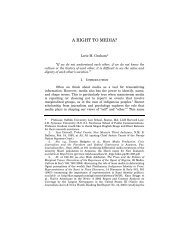The Right to Dignity Rex D. Glensy - Columbia Law School
The Right to Dignity Rex D. Glensy - Columbia Law School
The Right to Dignity Rex D. Glensy - Columbia Law School
You also want an ePaper? Increase the reach of your titles
YUMPU automatically turns print PDFs into web optimized ePapers that Google loves.
126 COLUMBIA HUMAN RIGHTS LAW REVIEW [43:65<br />
exhortations not <strong>to</strong> embark down a road that is unclear and open <strong>to</strong><br />
suggestion. <strong>The</strong> response <strong>to</strong> the criticisms would be: (1) courts in the<br />
United States have already referenced the right <strong>to</strong> dignity enough<br />
times that nothing about developing a specific dignity jurisprudence<br />
would be <strong>to</strong>tally “new”; and (2) given the ad hoc nature in which it is<br />
being deployed, it is the current state of use of dignity rights that is<br />
unclear, and therefore the proposal for a negative rights approach <strong>to</strong><br />
dignity rights is merely trying <strong>to</strong> bring order <strong>to</strong> this area, which<br />
critics should welcome. Indeed, Supreme Court decisions reflect how<br />
it is possible for the dignity of humanity <strong>to</strong> be expressed in its most<br />
universal form. Through the operation of law, the right <strong>to</strong> dignity<br />
becomes both the right being fostered and protected, as well as the<br />
justification for protecting it. It serves <strong>to</strong> reinforce those rights that<br />
we are most familiar with and <strong>to</strong> provide a grounding root that<br />
reaches beyond the state <strong>to</strong> a realm where rights are considered<br />
inherent rather than granted: “<strong>The</strong> value of legal norms often lies in<br />
what a legal system takes for granted, and thus what may stand<br />
beyond the immediate purview of political and judicial ac<strong>to</strong>rs and<br />
other participants in and observers of the system.” 280 <strong>The</strong> negative<br />
approach <strong>to</strong> the right <strong>to</strong> dignity fits neatly in<strong>to</strong> this definition. As<br />
aptly summarized by a commenta<strong>to</strong>r, the negative right <strong>to</strong> dignity,<br />
i.e., its role as a background normative principle of law, is simply the<br />
“‘right <strong>to</strong> have rights.’” 281<br />
C. Heuristic – <strong>The</strong> Proxy Approach<br />
<strong>The</strong> first two ways of approaching a right <strong>to</strong> dignity within<br />
American jurisprudence treat dignitary rights as existing<br />
independently of other rights, duties, and responsibilities that are<br />
already granted within the legal sphere. Thus, under those<br />
approaches, an injury <strong>to</strong> an individual’s human dignity could, in<br />
theory, without affecting another cognizable right, give rise <strong>to</strong> a cause<br />
of action either against a private party or the government (depending,<br />
of course, on who caused the injury in the first place). Under the<br />
proxy approach <strong>to</strong> the right <strong>to</strong> dignity, the invocation of a dignitary<br />
interest in a particular circumstance does not signify something<br />
independent of another enumerated right, but rather acts as a proxy<br />
for that right (be that right related <strong>to</strong> a liberty or an equality interest<br />
for example). In this context, the use of dignity functions as a<br />
heuristic—a cognitive device that serves as an aid <strong>to</strong> solve a complex<br />
280. Carozza, supra note 79, at 939.<br />
281. See Stinneford, supra note 268, at 592.















